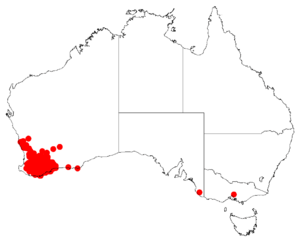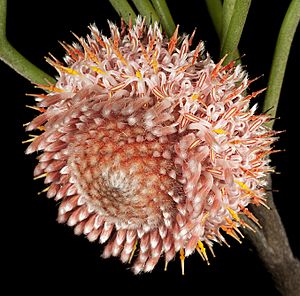Nodding coneflower facts for kids
Quick facts for kids Nodding coneflower |
|
|---|---|
 |
|
| Scientific classification | |
| Genus: |
Isopogon
|
| Species: |
teretifolius
|
 |
|
| Where the Nodding Coneflower grows in Australia | |
The Nodding Coneflower, or Isopogon teretifolius, is a special flowering plant. It is part of the Proteaceae plant family. This plant grows only in the southwest area of Western Australia.
It is a shrub that stands upright. It has leaves that look like thin tubes, and its flowers are pinkish and hairy. They grow in round, flattened groups that sometimes hang down, giving the plant its "nodding" name.
Contents
What the Nodding Coneflower Looks Like
The Nodding Coneflower is a shrub that usually grows between 0.5 and 2 meters (about 1.5 to 6.5 feet) tall. Its small branches are covered in fine hairs and are pale to grayish-brown.
Its leaves are shaped like cylinders, measuring 25 to 100 millimeters (about 1 to 4 inches) long. Sometimes, these leaves are divided into smaller parts, but each part is still narrow, about 1.5 to 2 millimeters wide. The tip of each leaf or leaf segment is sharply pointed.
The flowers grow at the ends of the branches. They are grouped together in flat, round heads that are 25 to 40 millimeters (about 1 to 1.5 inches) across. These flower heads can sometimes droop or "nod." At the base of the flower heads are reddish-brown, egg-shaped leaves called involucral bracts, which are also hairy.
The individual flowers are creamy pink, light pink, or white with a pink tint. They are hairy and can be up to 15 millimeters (about 0.6 inches) long.
Flowering and Fruit
Nodding Coneflowers usually bloom from August to November. After flowering, the plant produces fruit. The fruit is a hairy nut. Many of these nuts grow together in a flattened, round, or cone-shaped head. This fruit head is about 20 to 25 millimeters (about 0.8 to 1 inch) wide.
How it Was Named
The Nodding Coneflower was first officially described in 1810. A famous botanist named Robert Brown gave it its scientific name, Isopogon teretifolius. He wrote about it in a scientific paper for the Linnean Society of London.
The second part of its scientific name, teretifolius, comes from Latin. It means "terete-leaved," which describes its round, tube-like leaves.
Where it Grows
The Nodding Coneflower is found in different types of natural areas in southwest Western Australia. It grows in forests, areas with many shrubs (shrubland), and open, low-growing plant areas (heath).
You can find it in many regions, including the Avon Wheatbelt, Esperance Plains, Geraldton Sandplains, Jarrah Forest, Mallee, and Swan Coastal Plain.
Conservation Status
The Government of Western Australia's Department of Parks and Wildlife has looked at the Nodding Coneflower. They have classified it as "not threatened." This means that currently, there are enough of these plants in the wild, and they are not in danger of disappearing.


